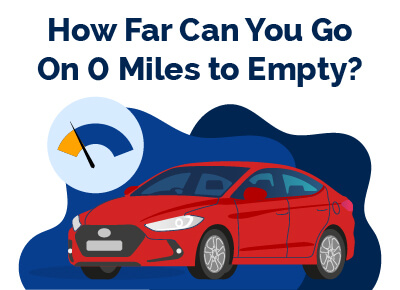How Far Can You Go on 0 Miles to Empty?
June 11, 2023


Chris is Head of Content for FindTheBestCarPrice and is based out of Philadelphia, PA. As a seasoned automotive industry analyst and car enthusiast, he ensures the highest level of quality across all our content and curates our picks for the best deals each month.
Chris studied information systems and marketing at Drexel University and writes about a wide range of topics ranging from car buying tips to troubleshooting common mechanical issues.
When he’s not thinking about cars, he likes to stay in with his dog and make an “attempt” to finish a crossword puzzle (he’s not quite at the Saturday/Sunday level…yet). As a former cheesemonger, Chris still has a “sharp” passion for all things cheese, and his fridge is always loaded with it!
Chris also has a passion for things that go fast, and drones are no exception. He spends some of his time writing for Dronesourced.
So, with your gas tank light on, and your mileage calculator reading zero, it's obvious that your car is about to come to a stop. But how far can you keep going before your car finally stops? How many miles can you achieve after gas says 0?
The truth is, how far you can go on 0 miles to empty greatly depends on the car that you are driving. The fuel economy and gas system of the vehicle determines how far you'll go even when the gauge reads empty.
This implies that you might be able to go 32 miles on 0 miles to empty with a Honda Fit, but a truck might not take you that far when your gas gauge reads zero miles to empty. However, on an average scale, you can expect to go as far as 25 to 50 miles on 0 miles to empty.
We've curated this article to teach you all you need to know about how far you can go on 0 miles to empty.
Table of Contents
- How Far Can You Go on 0 Miles to Empty?
- Factors That Determine How Far You Can Go on 0 Miles to Empty
- How Does Distance To Empty Work in Cars?
- What Is The Best Way To Calculate the Distance You Can Drive on Empty?
- How Do I Make Sure That My Mileage Is Correct?
- How Can I Improve My Fuel Efficiency?
- Conclusion
- Best Car Deals by Category
- Frequently Asked Questions
How Far Can You Go on 0 Miles to Empty?
The first thing that you must understand is that your gas tank is not empty when your gauge reads 0 miles to empty. You can drive for quite a distance before it finally stops.
However, the distance you will get isn't the same for all vehicles and sometimes will vary on different occasions, even with the same car.
On an average scale, you should expect to drive around 25 to 50 miles on 0 miles to empty. In extreme conditions, you can get up to 60 miles. However, this depends on the type of car you are driving and the conditions surrounding your driving.
Factors That Determine How Far You Can Go on 0 Miles to Empty
There are a lot of factors that determine how far you can go on 0 miles to empty. These factors are the reasons why you might get 20 miles on a rainy day and 45 miles on a dry day.
It's important to mention that the mile readings on your car's dashboard are not always correct. Most times, the readings are simply mileage estimates of what it believes your car should cover in the right conditions.
This implies that the amount of fuel that your car will consume on rough terrains is higher than what you'll get on straight roads without traffic.
Here's a list of factors that can determine how far you can go on 0 miles to empty.
1. The Type of Car That You Drive
The type of car you drive greatly determines how far you will go on 0 miles to empty. This usually covers how heavy the car is and the fuel technology.
Your car will go farther on 0 miles to empty if it's a light, small car, compared to how poor it will perform if you're driving a truck. This is because heavy cars demand more energy and fuel to move.
If your car is equipped with a diesel engine, you're sure of getting better gas mileage than what you'll get from gasoline engines.
2. Driving Style
This is usually the most neglected scenario among drivers. Your driving style, which covers how fast you drive, how much you rev, and the overall aggressiveness of your driving, determines how much fuel you'll use.
This also determines how far you'll go with 0 miles to empty. If you accelerate too much, hit the brakes hard, and always run at high speed, there's no way you'll be able to achieve good gas mileage.
3. Driving Conditions
One of the major driving conditions that influence how far you can go driving from 0 miles to empty is the terrain you're driving on.
You can't expect to save as much fuel as you will driving on the streets when you have a mountain ride.
4. Fuel Economy of Your Car
The fuel economy of your car is a major determinant of how far you'll go before your gas tank goes empty.
No matter how slow or careful you drive, if your car's fuel economy is bad, you won't cover so many miles driving on 0 miles to empty.
5. Tire Condition
The condition of your tires plays a great role in determining how far you can go on a zero gas reading. If your tires are unevenly worn or poorly inflated, there's no way you'll get good fuel economy.
6. Weather Condition
Weather conditions can determine how far you can go with a near-empty gas reading. During cold weather, your engine will need more power and demand more energy to work efficiently, increasing fuel consumption.
How Does Distance To Empty Work in Cars?
The distance to empty reading is a feature that indicates or estimates the total distance your car can travel before it finally runs out of fuel. Sometimes, the gas mileage isn't accurate, but it can help you estimate how far you can drive before the remaining fuel in your tank finishes.
For improved accuracy, most car brands install sensors in their fuel tanks to help detect the amount of fuel remaining in the tank. Your car gets the kilometer readings as you proceed with the journey, including the quantity of fuel in the tank along the journey.
The distance to empty is calculated by dividing the distance traveled by the amount of fuel used and multiplying it by the total amount of fuel left in the tank.
What Is The Best Way To Calculate the Distance You Can Drive on Empty?
The best way to calculate the distance you can drive on empty is to keep track of your average fuel consumption for at least the last 30 to 40 miles.
This will help you estimate average figures of your fuel consumption, especially across different weather conditions. It is important that you confirm your speed ratings during these intervals.
After learning the figures, you can calculate the distance you will likely cover on empty by multiplying the total amount of fuel left in your tank at a particular interval with the quotient of the distance traveled and the fuel used.
How Do I Make Sure That My Mileage Is Correct?
Are you in doubt that your mileage is inaccurate or your odometer is reading fraudulent gas readings? Here are ways you can make sure that your mileage is correct.
- Check your vehicle documents, service, and not certificates to confirm consistency in the mileage readings.
- Run computer diagnostics to determine the accuracy of your odometer.
- Look for damages or tampering in your odometer.
- Visit a professional mechanic to make sure that the mileage is correct.
How Can I Improve My Fuel Efficiency?
One of the ways that you can get your car to drive farther than usual is to improve your fuel efficiency.
Here are quick ways to improve your fuel efficiency:
- Inflate your tires properly.
- Don't load your car with too many loads.
- Drive normally: not too fast, not too slow.
- Don't hit the brakes too hard.
- Ensure regular maintenance on your car.
- Use the fuel technologies in your car.
- Don't rev your engines.
- Stay away from rough roads.
Conclusion
You must understand that even though it's estimated that you can go up to 25 - 50 miles on 0 miles to empty, the figures are not always exact.
You'll notice variations in different occurrences depending on your driving habits, the state of your vehicle, and the conditions impacting your driving. Whichever way it goes, make sure that you always ensure that your fuel system is working properly.
Best Car Deals by Category
Frequently Asked Questions
Why does my miles to empty change?
Your miles to empty will change because your fuel consumption rate isn't the same. You'll have different fuel levels at different driving conditions and speed levels. The truth is, your miles to empty will get better when you have a good fuel economy. It will worsen when your fuel efficiency is bad.
How much petrol is left when the fuel light comes on?
Your fuel light will come on when the petrol left in your tank is very low. The fuel limit will vary depending on the type of car that you are driving, but it will always fall between 10 - 15%.
How do I know if my petrol tank is empty?
You can easily know your petrol tank is empty when your fuel light comes on. Aside from the illumination of the fuel light, you can know if your petrol tank is empty when the gauge on your dashboard reads empty.
How accurate is the miles-to-empty?
The accuracy of the miles-to-empty indicator is quite relative, good enough for you to depend on them. The goal of miles-to-empty indicators isn't to achieve 100% accuracy but to give you heads-up on the need to refuel your tank. In most cases, there are error occurrences up to 2.2 - 3.8 mpg with the least error margin of 0.1 mpg.
Posted in Car Buying Tips, Car Troubleshooting |




